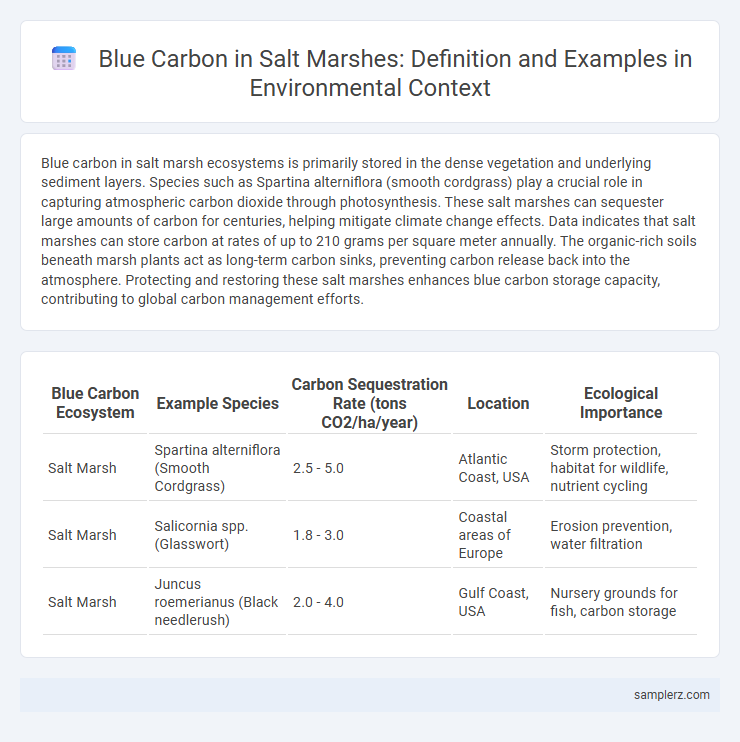Blue carbon in salt marsh ecosystems is primarily stored in the dense vegetation and underlying sediment layers. Species such as Spartina alterniflora (smooth cordgrass) play a crucial role in capturing atmospheric carbon dioxide through photosynthesis. These salt marshes can sequester large amounts of carbon for centuries, helping mitigate climate change effects. Data indicates that salt marshes can store carbon at rates of up to 210 grams per square meter annually. The organic-rich soils beneath marsh plants act as long-term carbon sinks, preventing carbon release back into the atmosphere. Protecting and restoring these salt marshes enhances blue carbon storage capacity, contributing to global carbon management efforts.
Table of Comparison
| Blue Carbon Ecosystem | Example Species | Carbon Sequestration Rate (tons CO2/ha/year) | Location | Ecological Importance |
|---|---|---|---|---|
| Salt Marsh | Spartina alterniflora (Smooth Cordgrass) | 2.5 - 5.0 | Atlantic Coast, USA | Storm protection, habitat for wildlife, nutrient cycling |
| Salt Marsh | Salicornia spp. (Glasswort) | 1.8 - 3.0 | Coastal areas of Europe | Erosion prevention, water filtration |
| Salt Marsh | Juncus roemerianus (Black needlerush) | 2.0 - 4.0 | Gulf Coast, USA | Nursery grounds for fish, carbon storage |
Introduction to Blue Carbon in Salt Marshes
Blue carbon in salt marshes refers to the carbon captured and stored by coastal vegetated ecosystems, including salt marsh plants like Spartina alterniflora. These ecosystems sequester large amounts of carbon in their biomass and sediments, playing a critical role in mitigating climate change by reducing atmospheric CO2 levels. Salt marshes can store carbon for centuries, making them vital blue carbon reservoirs essential for ecosystem services and carbon management strategies.
Key Salt Marsh Species Storing Blue Carbon
Spartina alterniflora, a dominant salt marsh grass, plays a crucial role in storing blue carbon by sequestering significant amounts of atmospheric CO2 in its biomass and sediment. Another key species, Juncus roemerianus, contributes to carbon storage through its extensive root systems that enhance soil carbon accumulation. Together, these salt marsh plants create dense, organic-rich sediments that act as long-term carbon sinks, supporting climate change mitigation efforts.
Carbon Sequestration Processes in Salt Marshes
Salt marshes are highly efficient ecosystems for blue carbon storage, primarily sequestering carbon through the accumulation of plant biomass and sedimentation. The dense root systems of salt marsh vegetation trap organic material and enhance soil carbon content, while slow decomposition rates under waterlogged, anoxic conditions preserve stored carbon. Carbon sequestration in salt marshes significantly mitigates atmospheric CO2 levels, supporting climate change mitigation efforts globally.
Role of Root Systems in Blue Carbon Storage
Root systems in salt marshes play a crucial role in blue carbon storage by stabilizing sediments and enhancing organic carbon accumulation. Dense, fibrous roots create anoxic soil conditions that slow down decomposition, allowing significant sequestration of carbon belowground. These roots also facilitate nutrient cycling and support microbial communities essential for long-term carbon retention in coastal ecosystems.
Case Study: Salt Marsh Blue Carbon in the United States
Salt marshes in the United States, particularly along the Atlantic and Gulf coasts, serve as vital blue carbon ecosystems by sequestering significant amounts of carbon dioxide in their sediment and plant biomass. A case study in the Chesapeake Bay highlights these marshes capturing up to 210 grams of carbon per square meter annually, demonstrating their role in climate change mitigation. Restoration projects in regions like Louisiana show enhanced carbon storage potential, emphasizing the importance of protecting these coastal wetlands for carbon offset strategies.
Salt Marsh Restoration for Enhanced Blue Carbon
Salt marsh restoration significantly enhances blue carbon sequestration by promoting the growth of vegetation such as Spartina alterniflora, which captures and stores large amounts of atmospheric CO2 in both plant biomass and sediment. Restored salt marshes improve tidal flushing and sediment deposition, increasing carbon burial rates and reducing greenhouse gas emissions. These ecosystems provide critical habitat while contributing to climate mitigation through long-term carbon storage.
Comparing Blue Carbon in Salt Marshes to Other Ecosystems
Salt marshes sequester carbon at rates comparable to mangroves, capturing approximately 210 grams of carbon per square meter annually, surpassing many terrestrial forests. Unlike seagrass beds, salt marshes store carbon in deep, waterlogged soils, preventing rapid decomposition and enhancing long-term carbon storage. This efficient carbon sequestration makes salt marshes critical blue carbon ecosystems for mitigating climate change.
Human Impacts on Salt Marsh Blue Carbon Stocks
Human activities such as coastal development and pollution significantly reduce salt marsh blue carbon stocks by disrupting plant root systems and sediment accumulation. Construction and dredging increase erosion and sediment compaction, impairing the marsh's ability to sequester carbon effectively. Nutrient runoff from agriculture can alter vegetation composition, decreasing carbon storage capacity in these vital coastal ecosystems.
Monitoring and Measuring Blue Carbon in Salt Marshes
Monitoring and measuring blue carbon in salt marshes involves quantifying soil carbon stocks using core sampling and remote sensing technologies to assess carbon sequestration rates accurately. Researchers employ standardized protocols for assessing aboveground and belowground biomass, coupled with methane flux measurements, to understand carbon storage dynamics and greenhouse gas emissions. Continuous data collection supports conservation strategies that enhance salt marsh resilience and maximize blue carbon potential in mitigating climate change.
Future Prospects for Salt Marsh Blue Carbon Conservation
Emerging research highlights the potential for enhanced blue carbon sequestration through the restoration and protection of salt marshes, which store up to 20,000 metric tons of carbon per square kilometer. Advanced monitoring technologies and nature-based solutions are being integrated to boost carbon capture efficiency and resilience against climate change impacts. Scaling up conservation efforts could position salt marshes as critical natural assets for achieving global carbon reduction targets and coastal ecosystem sustainability.

example of blue carbon in salt marsh Infographic
 samplerz.com
samplerz.com